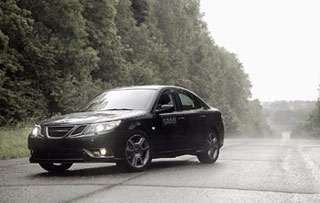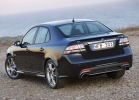Saab Turbo X test drive since 2008 sedan
Born to fly, the first Saab Turbo X test
 Do you know what a joke is in the camp of Saabakovod, how do they call themselves?
Do you know what a joke is in the camp of Saabakovod, how do they call themselves? Rule one: this Saabakovod must develop maximum speed.
The second rule: this Saabakovod must lose their rights for an unthinkable speed excess.
The third rule: a real saabakovod must fly off the road (explained simply: the classic of the Saabs, the model 900 had bad weight.
Considering that a lot of cameras that fix the speed appeared on the roads, and the Turbo X accelerates to hundreds in less than six seconds, you can realize the first two rules on the new Saab Turbo X as soon as you get numbers for a new car. But the last rule can only be performed intentionally, and all thanks to the first full -wheel drive system on the SAAB.
 Last Friday, we talked about the front-wheel drive Saab 9-3 in the convertible version. The front-wheel drive 9-3 is good for everyone, especially with a 255 hp engine. But a powerful motor traditionally imposes restrictions on the front -wheel drive car. If the speed is exceeded, a situation occurs when it is impossible to deal with the demolition of the front axis, this is the trouble of all front -wheel drive cars, especially powerful ones. So far, the only solution of insufficient rotation has announced Ford for the new Focus RS. According to the designers, Ford MacPherson Revoknucle allows you to realize 300 horsepower. We’ll see how to see how close it is to reality. So far, the most effective way to achieve a large torque remains all -wheel drive.
Last Friday, we talked about the front-wheel drive Saab 9-3 in the convertible version. The front-wheel drive 9-3 is good for everyone, especially with a 255 hp engine. But a powerful motor traditionally imposes restrictions on the front -wheel drive car. If the speed is exceeded, a situation occurs when it is impossible to deal with the demolition of the front axis, this is the trouble of all front -wheel drive cars, especially powerful ones. So far, the only solution of insufficient rotation has announced Ford for the new Focus RS. According to the designers, Ford MacPherson Revoknucle allows you to realize 300 horsepower. We’ll see how to see how close it is to reality. So far, the most effective way to achieve a large torque remains all -wheel drive. SAAB XWD is equipped with an all -wheel drive transmission with a long -term fourth -generation Haldex. So far, this node is put only on all -wheel drive Saabs, but in the future they will be equipped with Opel Insignia and Cadillac BLS. The new Chaldeks differs not only in smaller dimensions and efficiency, but is also able to predict the actions of the driver. Under normal conditions, the system transfers almost the entire torque to the front wheels, this improves exchange rate stability and saves fuel. At a sharp start, on the contrary, most of the torque will indulge in the rear wheels. For the distribution of the moment, the rear inter -long differential with electronic control was introduced in the bend. In a steep turn, when it is likely to demolish the front of the front, most of the moment is transmitted to the rear axle, and the differential distributes it to the outer wheel, helping the car screw into the turn. Haldex and the electronic differential works with the stabilization system. The latter intervenes only after the start of deep slipping or sharp correction by the steering wheel. Until this moment, handling lies on the chaldx.
 The test drive arranged by GM at the Dmitrovsky training ground made it possible to evaluate this in safe conditions. It is a pity that the races were not fixed with equipment. It is interesting to check how different the front-wheel drive 9-3 XWD without differential and XWD with the ELSD differential. Why did the Saabovites not introduce a self -locking differential into the front -wheel drive? According to the designers, this does not make much sense. The front-wheel drive 9-3 are not bought by racers-rings, erasing rubber for 100 kilometers. And in the case of slipping on slippery coating, the role of self -block is successfully performed by electronic blocking, which slows down the skid wheels.
The test drive arranged by GM at the Dmitrovsky training ground made it possible to evaluate this in safe conditions. It is a pity that the races were not fixed with equipment. It is interesting to check how different the front-wheel drive 9-3 XWD without differential and XWD with the ELSD differential. Why did the Saabovites not introduce a self -locking differential into the front -wheel drive? According to the designers, this does not make much sense. The front-wheel drive 9-3 are not bought by racers-rings, erasing rubber for 100 kilometers. And in the case of slipping on slippery coating, the role of self -block is successfully performed by electronic blocking, which slows down the skid wheels. External differences of Turbo-X, primarily in color. Sedans and station wagons of special series (TURBO X cars will be released only 2000 pieces) are painted only in the Jet Black color. The wheels and part of the external decor are stylized as a titanium. Front air intakes are enlarged for better cooling of intercooler radiators. In addition, the car took place careful refinements in the aerodynamic pipe. All diffusers and spoilers are not a props, but really working elements.
 Another external difference is exhaust pipes. For Turbo X, they are made in the form of two parallelepipeds. The pipes are also not a props. During the 9-3 test, I noted that despite the powerful motor, the car turned out to be too comfortable in acoustic terms. After the ignition, the motor in Turbo X comes to life, reporting this a formidable gurgle, which is replaced by a cheerful roar during acceleration.
Another external difference is exhaust pipes. For Turbo X, they are made in the form of two parallelepipeds. The pipes are also not a props. During the 9-3 test, I noted that despite the powerful motor, the car turned out to be too comfortable in acoustic terms. After the ignition, the motor in Turbo X comes to life, reporting this a formidable gurgle, which is replaced by a cheerful roar during acceleration. The XWD salon is identical to 9-3, with the exception of the seats. Sports car sports seats. Here they are more massive, with more pronounced side support, in addition, some panels are trimmed with carbon. And of course, compared to the version of Convertible, from behind it is really to fit three men. A similar situation with the trunk, it is noticeably larger, and the backs of the seats can be folded.
 The power of all -wheel drive Saabs was increased from 255 to 280 hp. Full -wheel drive allows you to realize all the traction. A six -speed automatic or mechanic is offered to a client to choose from. The price of an all-wheel drive sedan 9-3 begins with 1 million 286 thousand rubles, the station wagon is more expensive.
The power of all -wheel drive Saabs was increased from 255 to 280 hp. Full -wheel drive allows you to realize all the traction. A six -speed automatic or mechanic is offered to a client to choose from. The price of an all-wheel drive sedan 9-3 begins with 1 million 286 thousand rubles, the station wagon is more expensive. Exclusive TURBO X SAABs will be produced in total 2000 pieces, and there is no doubt, in 15 years they will become the same subject of pride as today 900 Turbo. Do you know why in Russia the SAAB brand is considered no less prestigious than Mercedes? Because in the dashing 90s, Yeltsin’s business management purchased a huge batch of 9000-Saabs for the presidential administration. In the days of Berezovsky, only respected people rode on these Swedes. At that time, Russia even took second place in the world for the sale of Saabs!
This year, when they made a decision on the release of Turbo X, 29 cars were planned to be delivered to Russia, however, after the announcement of the start of sales, they all bought them. After that, a quota of 15 cars was allocated twice to Russia.
Yaroslav Marshalkin
Source: Auto.mail.ru







